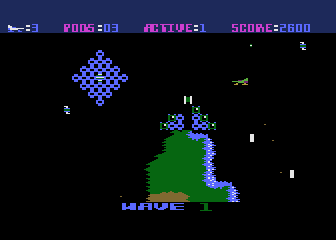Shadow World (video game)
| Shadow World | |
|---|---|
 | |
| Publisher(s) | Synapse Software |
| Programmer(s) | Mike Potter |
| Platform(s) | Atari 8-bit |
| Release date(s) | 1983 |
| Genre(s) | action |
| Mode(s) | single or two player |
Shadow World is a 1983 video game for the Atari 8-bit family written by Mike Potter and distributed by Synapse Software.
The game is a shooter in which the players are in charge of defending their planet from an alien invasion. The game supports two players at once, splitting the screen vertically into two halves, and merging them on the fly when both players are in the same location.
History
Shadow World was the last in a series of games Potter wrote for Synapse in a one year period between November 1981. All of these games made use of smooth scrolling and demonstrated an evolution in technique, growing more graphically complex over time, and becoming much faster paced.[1]
Potter's royalties were shrinking over time, eventually reaching 80 cents a game sold. At the same time copyright infringement was rampant. When he saw that his own brother in law had made unlicensed copies of all his games, he decided to leave the games market. He turned to the nascent IBM PC market, but also released a few more Atari titles with other labels.[1]
Gameplay

The game shares elements of Potter's first Atari game, Protector, itself based graphically on the arcade game, Defender. Like Defender, the action is primarily side-scrolling on a map that wraps around to allow continual travel to the left or right. Shadow World adds a limited amount of vertical scrolling motion as well. Compared to Protector, Shadow World has much more action with significant numbers of moving objects. The game also shares elements with his earlier game Nautilus, notably the way the planet is laid out onscreen and the way the player has to destroy certain enemies by shooting their core.[1]
In Shadow World, the players are in charge of defending the planet of Jantor, which is under attack by the alien Rigillians who are attempting to steal the planet's supply of tricasmium, an element with unique multi-dimensional properties that are used as the basis of all modern technology. The Rigillians have launched "seed crystals" towards the planet from space, which emit small defensive drones as they fall towards the ground. The crystal can be destroyed by shooting through its outer shell to reach its inner core, but it periodically repairs its shell to counter these attacks.[2]
If the crystal touches the ground it mutates into a "colonizer" which cannot be destroyed by shooting it. These colonizers constantly emit seeker drones, acting as a defensive station protecting new seed crystals that are dropped. If five seed crystals manage to land and form colonizers, the planet explodes. The seed crystals also drop a surface skimmer which begins to collect the tricasmium nuggets found on the surface. The skimmer can be destroyed to save the supply of nuggets, which can be picked up and dropped on the colonizers to destroy them.[2]
The player's fighters, shaped either like the fighter from Protector (and thus Defender) or the helicopter from Fort Apocalypse, are armed with a gun firing to the left and right, as well as three smart bombs that destroy all the drones that are on the screen at the time it's activated. Using the smart bomb also returns the player to their base, which prevents it from being used immediately prior to attacking a crystal. The area around the base is protected by shields that prevent any Rigillians from entering the area above it.[2]
Reception
Shadow World received little press in spite of Potter's well-known reputation in the Atari market. Antic commented only on its frenetic pace, noting "After playing this game, you may never complain about rush-hour traffic again."[3] Potter rated it as his favorite game.[1]
References
Citations
- 1 2 3 4 Hague 2000.
- 1 2 3 Potter 1983.
- ↑ Morgan 1984.
Bibliography
- Hague, James (17 January 2000). "Mike Potter's Story". The Giant List of Classic Game Programmers.
- Morgan, Caitlin (February 1984). "New Products". ANTIC.
- Potter, Mike (1983). Shadow World User's Manual (PDF). Synapse Software.